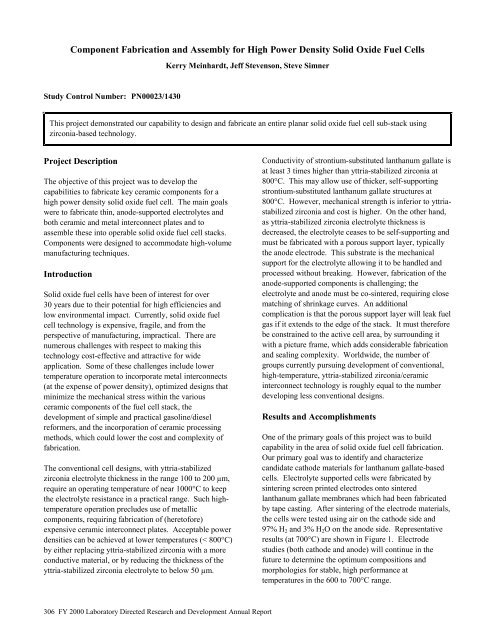PNNL-13501 - Pacific Northwest National Laboratory
PNNL-13501 - Pacific Northwest National Laboratory
PNNL-13501 - Pacific Northwest National Laboratory
You also want an ePaper? Increase the reach of your titles
YUMPU automatically turns print PDFs into web optimized ePapers that Google loves.
Component Fabrication and Assembly for High Power Density Solid Oxide Fuel Cells<br />
Study Control Number: PN00023/1430<br />
Kerry Meinhardt, Jeff Stevenson, Steve Simner<br />
This project demonstrated our capability to design and fabricate an entire planar solid oxide fuel cell sub-stack using<br />
zirconia-based technology.<br />
Project Description<br />
The objective of this project was to develop the<br />
capabilities to fabricate key ceramic components for a<br />
high power density solid oxide fuel cell. The main goals<br />
were to fabricate thin, anode-supported electrolytes and<br />
both ceramic and metal interconnect plates and to<br />
assemble these into operable solid oxide fuel cell stacks.<br />
Components were designed to accommodate high-volume<br />
manufacturing techniques.<br />
Introduction<br />
Solid oxide fuel cells have been of interest for over<br />
30 years due to their potential for high efficiencies and<br />
low environmental impact. Currently, solid oxide fuel<br />
cell technology is expensive, fragile, and from the<br />
perspective of manufacturing, impractical. There are<br />
numerous challenges with respect to making this<br />
technology cost-effective and attractive for wide<br />
application. Some of these challenges include lower<br />
temperature operation to incorporate metal interconnects<br />
(at the expense of power density), optimized designs that<br />
minimize the mechanical stress within the various<br />
ceramic components of the fuel cell stack, the<br />
development of simple and practical gasoline/diesel<br />
reformers, and the incorporation of ceramic processing<br />
methods, which could lower the cost and complexity of<br />
fabrication.<br />
The conventional cell designs, with yttria-stabilized<br />
zirconia electrolyte thickness in the range 100 to 200 µm,<br />
require an operating temperature of near 1000°C to keep<br />
the electrolyte resistance in a practical range. Such hightemperature<br />
operation precludes use of metallic<br />
components, requiring fabrication of (heretofore)<br />
expensive ceramic interconnect plates. Acceptable power<br />
densities can be achieved at lower temperatures (< 800°C)<br />
by either replacing yttria-stabilized zirconia with a more<br />
conductive material, or by reducing the thickness of the<br />
yttria-stabilized zirconia electrolyte to below 50 µm.<br />
306 FY 2000 <strong>Laboratory</strong> Directed Research and Development Annual Report<br />
Conductivity of strontium-substituted lanthanum gallate is<br />
at least 3 times higher than yttria-stabilized zirconia at<br />
800°C. This may allow use of thicker, self-supporting<br />
strontium-substituted lanthanum gallate structures at<br />
800°C. However, mechanical strength is inferior to yttriastabilized<br />
zirconia and cost is higher. On the other hand,<br />
as yttria-stabilized zirconia electrolyte thickness is<br />
decreased, the electrolyte ceases to be self-supporting and<br />
must be fabricated with a porous support layer, typically<br />
the anode electrode. This substrate is the mechanical<br />
support for the electrolyte allowing it to be handled and<br />
processed without breaking. However, fabrication of the<br />
anode-supported components is challenging; the<br />
electrolyte and anode must be co-sintered, requiring close<br />
matching of shrinkage curves. An additional<br />
complication is that the porous support layer will leak fuel<br />
gas if it extends to the edge of the stack. It must therefore<br />
be constrained to the active cell area, by surrounding it<br />
with a picture frame, which adds considerable fabrication<br />
and sealing complexity. Worldwide, the number of<br />
groups currently pursuing development of conventional,<br />
high-temperature, yttria-stabilized zirconia/ceramic<br />
interconnect technology is roughly equal to the number<br />
developing less conventional designs.<br />
Results and Accomplishments<br />
One of the primary goals of this project was to build<br />
capability in the area of solid oxide fuel cell fabrication.<br />
Our primary goal was to identify and characterize<br />
candidate cathode materials for lanthanum gallate-based<br />
cells. Electrolyte supported cells were fabricated by<br />
sintering screen printed electrodes onto sintered<br />
lanthanum gallate membranes which had been fabricated<br />
by tape casting. After sintering of the electrode materials,<br />
the cells were tested using air on the cathode side and<br />
97% H2 and 3% H2O on the anode side. Representative<br />
results (at 700°C) are shown in Figure 1. Electrode<br />
studies (both cathode and anode) will continue in the<br />
future to determine the optimum compositions and<br />
morphologies for stable, high performance at<br />
temperatures in the 600 to 700°C range.

















